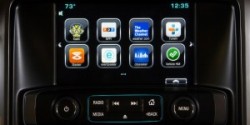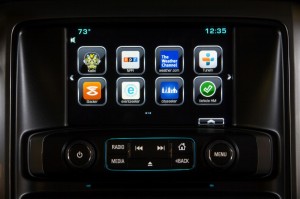In 2010 the first in-car receivers with Pandora integration rolled out. This year there were more announcements of dashboard integration with other radio apps like Stitcher, iHeartRadio and Slacker.
New smart dashboards permit drivers to operate these apps via their cars’ control system, but the catch is that they still have to use their smartphones and their smartphones’ mobile data for the connection. While the quality of these integrations have matured over the last four years, especially with the use of wireless Bluetooth connections, relying on the smartphone is still more of a hassle than listening to broadcast radio, especially for shorter trips. For in-car internet radio listening to become mainstream it has to become a fully built-in feature, like AM, FM and SiriusXM.
That’s why the most interesting announcements came from GM and Audi, which said 2015 models will have a 4G LTE mobile data connection, along with a wi-fi hotspot. GM’s offering will will first appear in some mid–2014 Chevrolet models as an option, then become standard on most Chevys in 2015. Audi will offer LTE in 2015 models of its A3 sedan.
Last year GM announced a dashboard app platform and released a software development kit in order to spur third-party development. With this year’s introduction of built-in mobile data, apps will be able to stream internet radio without a smartphone connection. GM’s AppShop is now live, and has radio offerings from the Weather Channel, NPR and Slacker Radio.
For its part, Audi debuted a 10.2“ Android tablet that interfaces directly with its automobiles, including a so-called ”Virtual Cockpit" displaying dashboard gauges.
More importantly, Audi and GM are part of the newly launched Open Automotive Alliance, anchored by Google. The group, whose members also include Honda and Hyundai, plans to develop a mobile operating system that integrates with Google’s Android OS. This portends more cars with fully independent internet connections and applications that access online radio platforms without tying up a smartphone.
The biggest potential speed bump for this trip is the mobile broadband connection itself. Both Audi and GM are partnering with AT&T, which will permit users to either share their smartphone data plan or establish a separate one. But with typical mobile data plans topping out around 4 GB a month, users could find themselves quickly racking up expensive overages with lots of in-car listening and using other data-intensive apps, especially with a back seat full of kids all watching different movies on Netflix.
Now, AT&T’s solution to this problem is to have app and platform companies sponsor this mobile bandwidth for you. While this sounds like a good idea for many users who would like to cut their data costs, as Matthew reported earlier this week, such “sponsored data” plans threaten to squeeze out programming from less well-heeled and non-profit providers, such as public and community radio.
Other wireless broadband providers offer unlimited data plans that would be attractive alternatives. But if your car only supports one carrier, like AT&T, where you can only get a data-limited plan, then you’re stuck.
Smart dashboards built on open standards, like Android, are an important step forward for in-car internet radio. The next, even more important step is to open up wireless connectivity to competition, too. There’s no fundamental technical reason why a given dashboard must be chained to one carrier.
While there are two different wireless standards in the US, there are multiple carriers for both standards. A car owner ought to be able to choose from amongst several mobile providers that are compatible with her model’s standard. An Audi or Chevrolet driver should at least be able to choose between T-Mobile and AT&T, which both support the LTE standard.
Still, such a choice is only a band-aid if programs like “sponsored data” are permitted to go forward unchecked. What would prevent or discourage all carriers from implementing this idea if AT&T finds it lucrative? The future of independent internet radio truly hangs in the balance.




